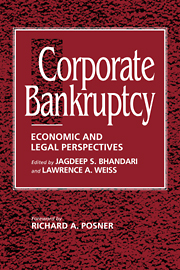Book contents
- Frontmatter
- Contents
- List of tables and figures
- Foreword by the HONORABLE RICHARD A. POSNER
- Preface
- Part I The role of credit
- Part II Bankruptcy as a reflection of the creditors' implicit bargain
- Part III Beyond the basic creditors' bargain
- 9 Bargaining after the fall and the contours of the absolute priority rule
- 10 On the nature of bankruptcy: An essay on bankruptcy sharing and the creditors' bargain
- 11 A simple noncooperative bargaining model of corporate reorganizations
- 12 Commentary on “On the nature of bankruptcy”: bankruptcy, priority, and economics
- 13 Bankruptcy and risk allocation
- 14 The corporate bankruptcy decision
- 15 Bargaining over equity's share in the bankruptcy reorganization of large, publicly held companies
- 16 Bankruptcy resolution: Direct costs and violation of priority of claims
- 17 The costs of conflict resolution and financial distress: Evidence from the Texaco-Pennzoil litigation
- 18 Survey of evidence on business bankruptcy
- Part IV Workouts or bargaining in the shadow of bankruptcy
- Part V Alternatives to bankruptcy and the creditors' bargain
- Part VI Experience of other countries
- Index
15 - Bargaining over equity's share in the bankruptcy reorganization of large, publicly held companies
Published online by Cambridge University Press: 10 December 2009
- Frontmatter
- Contents
- List of tables and figures
- Foreword by the HONORABLE RICHARD A. POSNER
- Preface
- Part I The role of credit
- Part II Bankruptcy as a reflection of the creditors' implicit bargain
- Part III Beyond the basic creditors' bargain
- 9 Bargaining after the fall and the contours of the absolute priority rule
- 10 On the nature of bankruptcy: An essay on bankruptcy sharing and the creditors' bargain
- 11 A simple noncooperative bargaining model of corporate reorganizations
- 12 Commentary on “On the nature of bankruptcy”: bankruptcy, priority, and economics
- 13 Bankruptcy and risk allocation
- 14 The corporate bankruptcy decision
- 15 Bargaining over equity's share in the bankruptcy reorganization of large, publicly held companies
- 16 Bankruptcy resolution: Direct costs and violation of priority of claims
- 17 The costs of conflict resolution and financial distress: Evidence from the Texaco-Pennzoil litigation
- 18 Survey of evidence on business bankruptcy
- Part IV Workouts or bargaining in the shadow of bankruptcy
- Part V Alternatives to bankruptcy and the creditors' bargain
- Part VI Experience of other countries
- Index
Summary
This chapter reports some of the results of an empirical study of the bankruptcy reorganization of large, publicly held companies. We present data relevant to what many consider to be the central issue of reorganization theory – how the value of the reorganizing enterprise should be divided among the various claims and interests. We demonstrate that there is indeed systematic deviation from the absolute priority rule in favor of junior interests; but, with respect to large, publicly held corporations, the debate about how to prevent these deviations is, for the most part, a tempest in a teapot – the difference between absolute priority and the actual outcomes of these cases is relatively small.
[Part I, on the legal context in which bargaining occurs, and Part II, on the history and theory of bargaining in bankruptcy cases, have been removed as they address issues discussed in other articles included in this volume.] Part III describe[s] our methodology. In Part IV we present our findings as to the frequency of “settlement” in these cases. In Parts V and VI, we present our findings as to the terms of settlement, comparing the legal entitlements of various participants in hypothetical adjudications and their recoveries under the actual settlement agreements. In these parts, we also discuss the possible reasons for “gaps” between the hypothetically correct solutions in adjudication (as provided by the absolute priority rule) and the settled outcomes. Part VII discusses the implications of these empirical findings for bankruptcy policy.
- Type
- Chapter
- Information
- Corporate BankruptcyEconomic and Legal Perspectives, pp. 232 - 259Publisher: Cambridge University PressPrint publication year: 1996



